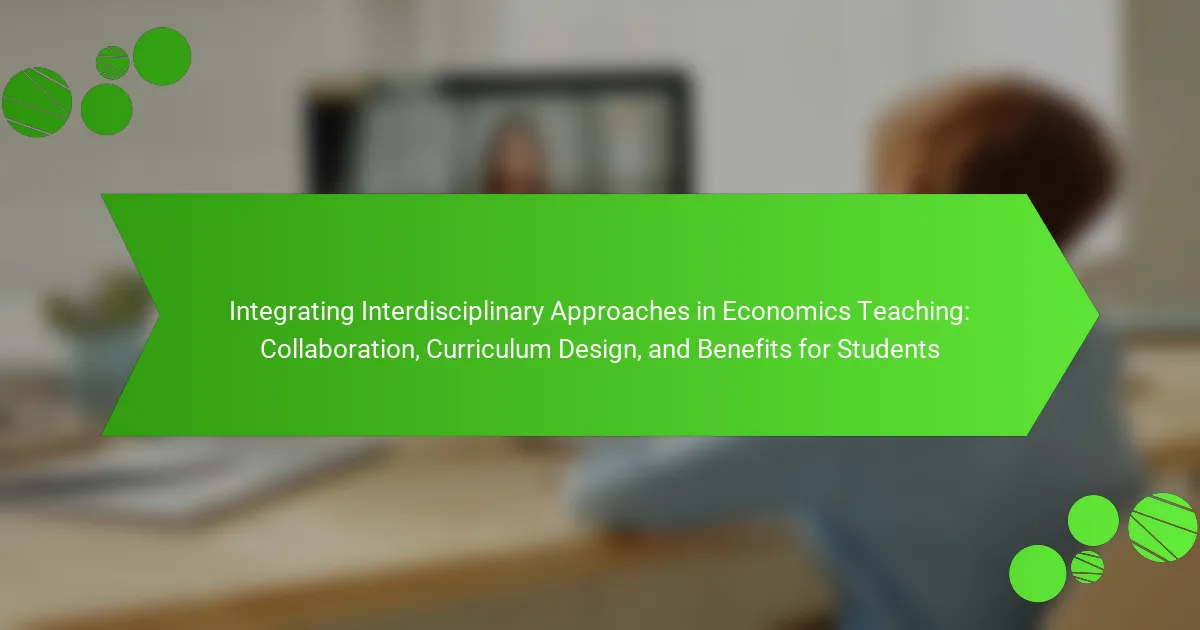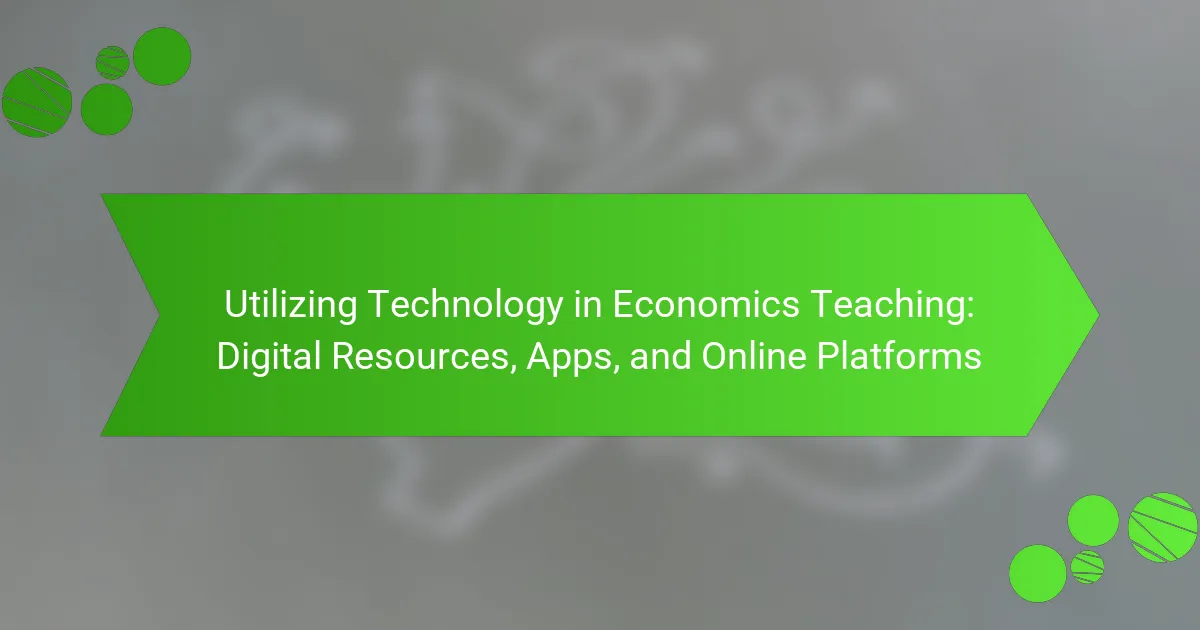Project-Based Learning (PBL) in Economics is an instructional method that immerses students in real-world economic challenges, fostering active learning through collaborative projects. This approach enhances critical thinking, problem-solving, and understanding of economic concepts while promoting teamwork and communication skills. The article outlines various frameworks for implementing PBL, such as the Buck Institute for Education model, the Gold Standard PBL framework, and the Inquiry-Based Learning framework, each emphasizing student engagement and real-world connections. Additionally, it details assessment criteria, including clarity of objectives and quality of presentation, to evaluate student performance. Expected outcomes from this learning approach include improved retention of knowledge, enhanced critical thinking abilities, and practical applications of economic principles.
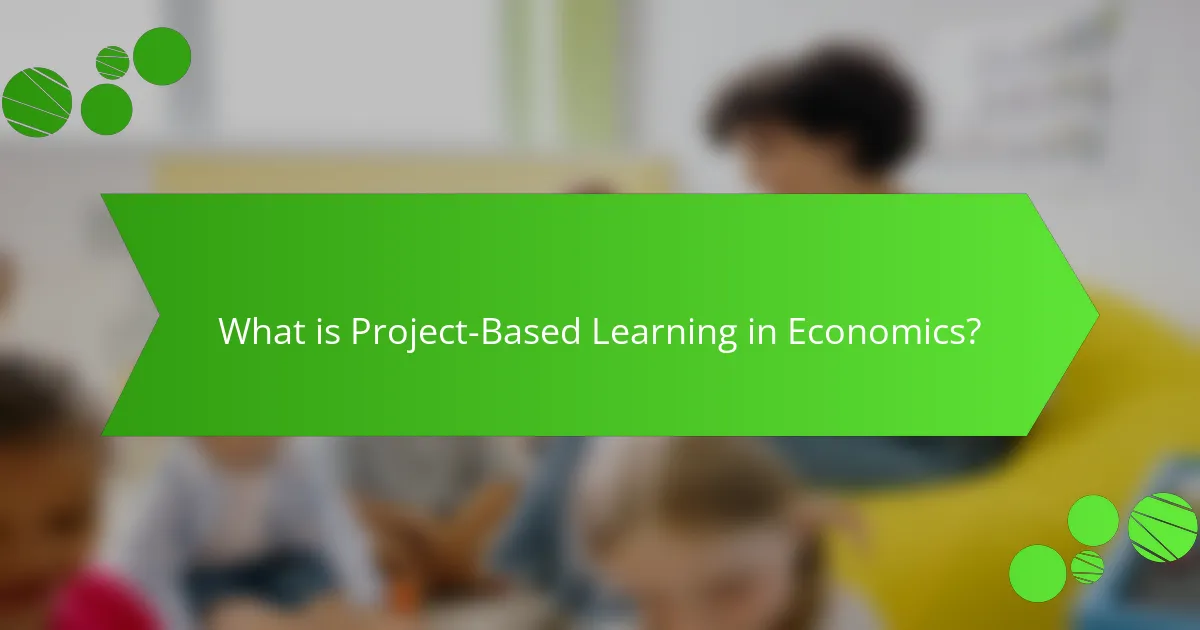
What is Project-Based Learning in Economics?
Project-Based Learning in Economics is an instructional approach that engages students in real-world economic problems. It emphasizes active learning through projects that require critical thinking and problem-solving. Students collaborate to research, analyze, and create solutions to economic issues. This method enhances understanding of economic concepts and theories. Research shows that project-based learning improves student motivation and retention of knowledge. It also fosters essential skills such as teamwork and communication. Overall, this approach aligns educational practices with practical applications in economics.
How does Project-Based Learning differ from traditional learning methods in economics?
Project-Based Learning (PBL) differs from traditional learning methods in economics by emphasizing active, hands-on engagement. In PBL, students work on real-world projects that require critical thinking and collaboration. Traditional methods often focus on rote memorization and passive learning through lectures. PBL encourages students to apply economic concepts in practical scenarios. Research shows that PBL enhances retention of knowledge and improves problem-solving skills. A study by Thomas Markham highlights that students in PBL environments demonstrate greater motivation and deeper understanding of economic principles. Therefore, PBL fosters a more dynamic and interactive learning experience compared to traditional approaches.
What are the key characteristics of Project-Based Learning in economics?
Project-Based Learning in economics emphasizes student engagement through real-world problems. It fosters critical thinking and problem-solving skills. Students collaborate in teams to explore economic concepts. This approach encourages active learning rather than passive absorption of information. Assessments focus on the process and final product. Reflection on learning experiences is integral to the methodology. Research shows that students retain knowledge better through hands-on projects. These characteristics enhance motivation and deepen understanding of economic principles.
How does the approach enhance student engagement in economics?
Project-Based Learning enhances student engagement in economics by promoting active participation. Students work on real-world projects that connect theoretical concepts to practical applications. This hands-on approach fosters critical thinking and problem-solving skills. Research shows that students retain information better when they apply it in meaningful contexts. For example, a study by Thomas Markham highlights increased motivation and collaboration among students engaged in project-based tasks. This method also encourages peer-to-peer learning, enhancing communication and teamwork abilities. Overall, the approach makes economics more relevant and interesting to students.
Why is Project-Based Learning important in the field of economics?
Project-Based Learning is important in the field of economics because it fosters critical thinking and real-world application of economic concepts. This educational approach engages students in hands-on projects that reflect actual economic scenarios. Students analyze data, conduct research, and collaborate on solutions. Such activities enhance their understanding of economic principles like supply and demand. Research shows that experiential learning improves retention and comprehension of complex topics. A study by Thomas Markham highlights that project-based learning increases student motivation and engagement in economics. This method prepares students for real-world challenges by developing problem-solving skills essential for economic decision-making.
What skills does Project-Based Learning develop in economics students?
Project-Based Learning develops critical thinking, collaboration, and problem-solving skills in economics students. Critical thinking enables students to analyze economic concepts and data effectively. Collaboration skills are enhanced as students work in teams to complete projects. Problem-solving skills are fostered through real-world economic challenges. Research shows that these skills lead to better academic performance and preparedness for the workforce. According to a study by Thomas Markham, students engaged in Project-Based Learning demonstrate improved engagement and retention of economic principles.
How does it prepare students for real-world economic challenges?
Project-based learning in economics prepares students for real-world economic challenges by engaging them in practical, hands-on experiences. This approach allows students to apply theoretical concepts to real-life scenarios. Through projects, students analyze economic data, conduct research, and develop solutions to current economic issues. They learn critical thinking and problem-solving skills essential for navigating complex economic environments. Additionally, collaboration in group projects fosters teamwork and communication abilities. Research shows that active learning techniques, like project-based learning, enhance retention and understanding of economic principles. A study by Thomas (2000) found that students involved in project-based learning demonstrate higher levels of engagement and improved academic performance in economics.
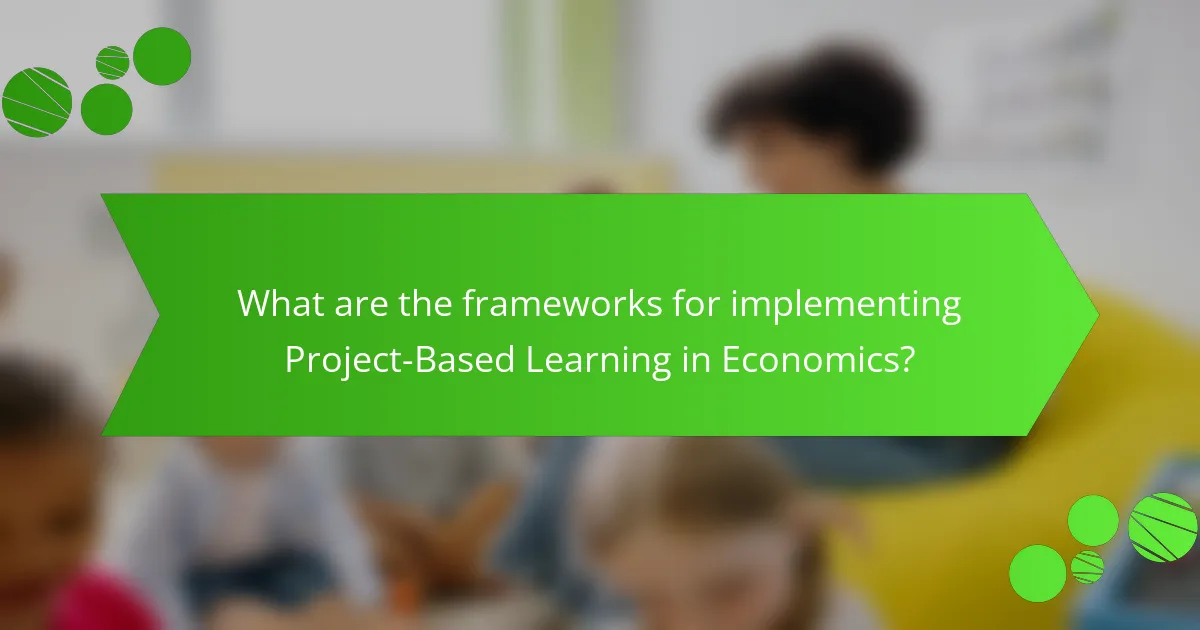
What are the frameworks for implementing Project-Based Learning in Economics?
The frameworks for implementing Project-Based Learning (PBL) in Economics include the Buck Institute for Education (BIE) model, the Gold Standard PBL framework, and the Inquiry-Based Learning framework. The BIE model emphasizes student voice and choice, real-world connections, and critical thinking. This model encourages students to investigate complex economic issues through hands-on projects. The Gold Standard PBL framework focuses on key elements like challenging projects, collaboration, and public products. This framework ensures that students engage deeply with economic concepts. The Inquiry-Based Learning framework promotes student-driven questions and exploration. This approach allows students to discover economic principles through research and analysis. Each framework supports active learning and enhances students’ understanding of economics through practical application.
What are the essential components of a successful Project-Based Learning framework?
A successful Project-Based Learning (PBL) framework includes several essential components. These components are project design, student engagement, collaboration, and assessment.
Project design involves creating meaningful projects that align with learning objectives. Effective projects should be relevant to students’ lives and encourage critical thinking. Student engagement is crucial; students must be motivated and interested in the project topic.
Collaboration fosters teamwork and communication skills among students. This component allows students to learn from each other and share diverse perspectives. Assessment in PBL is ongoing and formative. It includes self-assessment, peer assessment, and teacher feedback to guide learning.
Research indicates that these components enhance student outcomes. According to the Buck Institute for Education, PBL improves student retention, motivation, and performance in real-world tasks.
How can educators design effective projects within this framework?
Educators can design effective projects within the Project-Based Learning framework by aligning project goals with economic concepts. They should identify clear learning objectives that reflect curriculum standards. Projects must incorporate real-world economic issues to enhance relevance and engagement. Collaboration among students is essential for developing teamwork skills. Educators should provide structured guidance while allowing student autonomy in project development. Assessment criteria must be transparent and aligned with project objectives. Utilizing feedback loops during the project can improve student learning outcomes. Research indicates that projects designed with these principles lead to deeper understanding and retention of economic concepts.
What role does collaboration play in the framework?
Collaboration plays a crucial role in the framework of Project-Based Learning in Economics. It enhances student engagement and encourages diverse perspectives. Collaborative efforts lead to improved problem-solving skills among students. Research shows that teamwork fosters deeper understanding of economic concepts. Studies indicate that collaborative projects result in higher retention of knowledge. Effective collaboration also builds communication skills essential for future careers. In this framework, collaboration is not just beneficial but essential for achieving desired learning outcomes.
How can technology be integrated into Project-Based Learning in economics?
Technology can be integrated into Project-Based Learning in economics through various tools and platforms. Online simulations allow students to experience market dynamics in real-time. Collaborative platforms enable group projects, enhancing teamwork and communication skills. Data analysis software can help students interpret economic data effectively. Virtual presentations can showcase project outcomes to a broader audience. Learning management systems can streamline project organization and feedback. Mobile apps can provide access to economic news and trends. These integrations enhance engagement, facilitate deeper learning, and prepare students for real-world economic challenges.
What tools and resources support Project-Based Learning in economics?
Tools and resources that support Project-Based Learning in economics include digital platforms, collaborative tools, and curriculum guides. Digital platforms like Google Classroom facilitate project management and communication among students and teachers. Collaborative tools such as Padlet and Trello enhance teamwork and organization. Curriculum guides provide structured frameworks for project design and implementation. Additionally, resources like case studies and simulations offer real-world applications of economic concepts. Research shows that these tools enhance student engagement and understanding in economics education.
How does technology enhance the learning experience?
Technology enhances the learning experience by providing interactive tools and resources. These tools include multimedia presentations, educational software, and online collaboration platforms. Such resources engage students more effectively than traditional methods. For instance, studies show that students using technology in classrooms score higher on assessments. A report by the U.S. Department of Education found that technology can improve student engagement and motivation. Additionally, technology allows for personalized learning experiences tailored to individual student needs. This adaptability helps students progress at their own pace. Overall, the integration of technology in education fosters a more dynamic and effective learning environment.
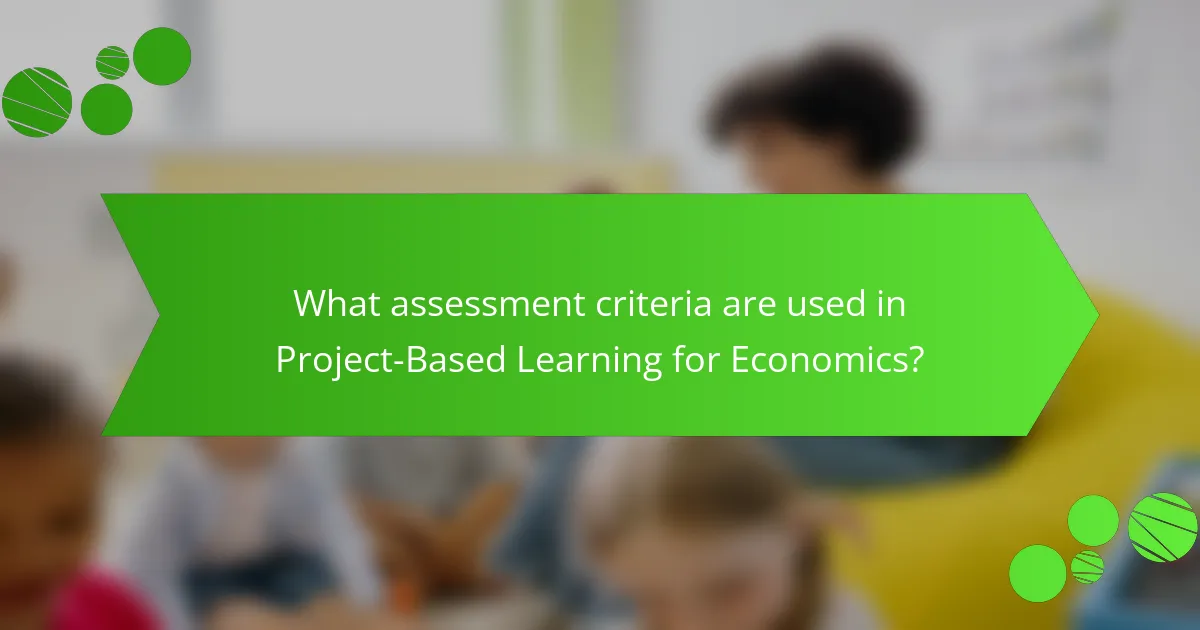
What assessment criteria are used in Project-Based Learning for Economics?
Assessment criteria used in Project-Based Learning for Economics include clarity of objectives, depth of research, application of economic concepts, and quality of presentation. Clarity of objectives evaluates how well students define project goals. Depth of research assesses the thoroughness and relevance of data gathered. Application of economic concepts measures the integration of theoretical knowledge into practical scenarios. Quality of presentation looks at how effectively students communicate their findings. These criteria ensure that students engage critically with economic principles and demonstrate their understanding through practical application.
How are student projects evaluated in Project-Based Learning?
Student projects in Project-Based Learning are evaluated through a combination of criteria including content knowledge, skills application, and presentation quality. Evaluation typically involves rubrics that outline specific performance indicators. These indicators assess how well students meet project objectives. Feedback is often provided by both peers and instructors. This dual feedback mechanism enhances learning and encourages self-reflection. Research shows that clear evaluation criteria improve student engagement and learning outcomes. A study by Thomas Markham highlights the importance of structured assessments in ensuring project success.
What are the key performance indicators for assessing student outcomes?
Key performance indicators for assessing student outcomes include academic achievement, skill development, and engagement levels. Academic achievement is measured through grades, test scores, and completion rates. Skill development can be evaluated by assessing critical thinking, problem-solving abilities, and collaboration skills. Engagement levels are determined by participation in class activities and project involvement. Research shows that these indicators correlate with overall student success in project-based learning environments. For instance, a study by Thomas Markham highlights that student engagement significantly impacts learning outcomes in project-based settings.
How can feedback be effectively provided to students?
Effective feedback can be provided to students through timely, specific, and actionable comments. Timeliness ensures that students can apply feedback while the material is still fresh. Specific feedback highlights particular strengths and areas for improvement, making it clear what actions students should take. Actionable comments guide students on how to enhance their work, such as suggesting resources or strategies. Research indicates that feedback is most effective when it is formative and ongoing, allowing students to reflect and improve continuously. A study by Hattie and Timperley (2007) emphasizes that feedback should focus on the task, the process, and self-regulation to maximize student learning outcomes.
What challenges may arise in assessing Project-Based Learning outcomes?
Challenges in assessing Project-Based Learning (PBL) outcomes include subjectivity in evaluation. Different evaluators may interpret project criteria variably. This can lead to inconsistent grading across similar projects. Additionally, measuring soft skills like collaboration and creativity is complex. Traditional assessment tools often fail to capture these skills effectively. Time constraints can also hinder thorough assessment. Educators may lack sufficient time to evaluate projects comprehensively. Furthermore, aligning PBL outcomes with standardized testing can be challenging. This misalignment may cause discrepancies in perceived student performance. Overall, these challenges complicate the assessment process in PBL contexts.
How can educators address common assessment challenges?
Educators can address common assessment challenges by implementing diverse assessment methods. These methods include formative assessments, which provide ongoing feedback and support learning. Summative assessments can evaluate overall student understanding at the end of a project. Rubrics can clarify expectations and provide consistent grading criteria. Peer assessments encourage student engagement and reflection on learning. Technology tools can streamline assessment processes and data collection. Professional development can equip educators with strategies to enhance assessment literacy. Research shows that varied assessment approaches improve student outcomes and engagement in project-based learning.
What strategies can improve the reliability of assessments?
To improve the reliability of assessments, implement standardized rubrics. Standardized rubrics provide clear criteria for evaluation. This consistency helps reduce subjective bias in grading. Training assessors on these rubrics enhances their understanding and application. Regular calibration sessions among assessors can further align grading practices. Incorporating multiple assessment methods increases reliability by providing varied data points. Feedback loops for students can clarify expectations and improve performance. Research shows that structured assessments lead to more reliable outcomes (Black & Wiliam, 1998).
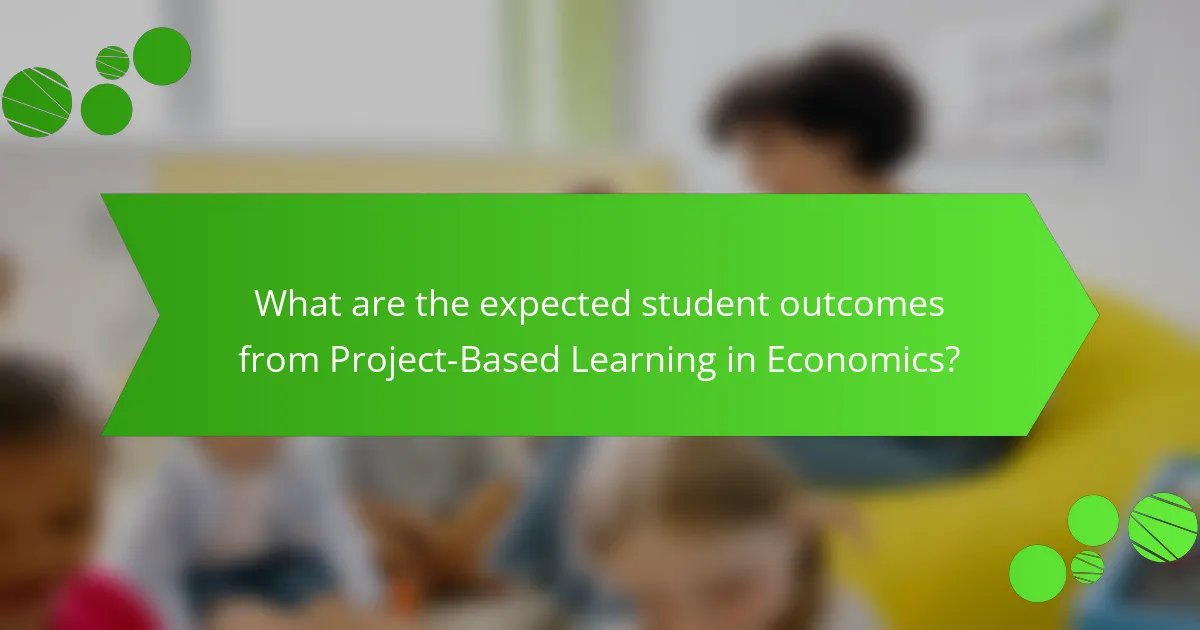
What are the expected student outcomes from Project-Based Learning in Economics?
Expected student outcomes from Project-Based Learning in Economics include enhanced critical thinking skills and improved problem-solving abilities. Students develop practical applications of economic concepts through real-world projects. They also gain experience in collaboration and communication while working in teams. Additionally, students learn to conduct research and analyze data relevant to economic issues. Engagement in Project-Based Learning fosters a deeper understanding of economic principles. Research indicates that students involved in such learning experiences often demonstrate higher retention of knowledge. A study by Thomas Markham highlights these outcomes, emphasizing the effectiveness of hands-on learning in economics education.
What knowledge and skills do students typically gain?
Students typically gain critical thinking and problem-solving skills through project-based learning. This approach encourages them to analyze real-world economic issues. They learn to collaborate effectively with peers on projects. Communication skills improve as students present their findings. Additionally, they acquire research skills by gathering and evaluating data. Understanding of economic concepts deepens as they apply theory to practice. Students also develop time management skills by meeting project deadlines. Overall, project-based learning fosters a well-rounded skill set essential for their future careers.
How does Project-Based Learning impact critical thinking and problem-solving skills?
Project-Based Learning enhances critical thinking and problem-solving skills by engaging students in real-world projects. This approach requires learners to analyze complex problems and develop solutions collaboratively. Research indicates that students in Project-Based Learning environments demonstrate improved analytical skills. A study by Thomas (2000) highlights that such learners often exhibit greater creativity and adaptability. Additionally, Project-Based Learning promotes self-directed learning, encouraging students to take initiative in their problem-solving processes. This method fosters a deeper understanding of subject matter, as students must apply knowledge in practical contexts. Overall, Project-Based Learning significantly contributes to the development of essential critical thinking and problem-solving abilities.
What role does reflection play in student learning outcomes?
Reflection significantly enhances student learning outcomes by promoting critical thinking and self-assessment. It allows students to analyze their experiences and understand their learning processes. Through reflection, students can identify strengths and areas for improvement. This process fosters deeper engagement with the material. Research indicates that reflective practices lead to improved academic performance. For instance, a study by Moon (2004) found that students who engage in reflection show higher levels of understanding and retention. Thus, reflection is essential for effective learning in project-based contexts.
How can educators measure the effectiveness of Project-Based Learning in economics?
Educators can measure the effectiveness of Project-Based Learning (PBL) in economics through various assessment methods. These methods include formative assessments, summative assessments, and student reflections. Formative assessments can involve quizzes and peer evaluations during the project. Summative assessments can consist of final presentations and reports that demonstrate understanding of economic concepts. Student reflections allow learners to articulate their learning experiences and insights gained from the project. Research indicates that PBL enhances critical thinking and problem-solving skills, which can be evaluated through specific tasks. A study by Thomas (2000) found that PBL leads to deeper understanding and retention of knowledge in students.
What tools can be used to track student progress and outcomes?
Learning management systems (LMS) are effective tools to track student progress and outcomes. These platforms allow educators to monitor assignments, grades, and attendance. Examples include Canvas, Moodle, and Blackboard. They provide analytics that help identify student engagement levels. Assessment tools like quizzes and surveys can measure understanding in real-time. Additionally, e-portfolios showcase student projects and reflections on learning. Data from these tools inform instructional adjustments. Research indicates that regular tracking improves student performance and accountability.
How can success stories be shared to promote Project-Based Learning?
Success stories can be shared to promote Project-Based Learning through various platforms and formats. Educators can utilize social media to highlight successful projects and their outcomes. Creating video testimonials from students can showcase their experiences and achievements. Hosting webinars or online workshops allows for real-time sharing and discussion of these stories. Blogs and newsletters can feature written accounts of successful projects, providing detailed insights. Collaboration with local media can help reach a wider audience by sharing success stories in community news segments. Educational conferences can serve as venues for presenting these stories to peers, fostering inspiration and ideas. Research indicates that sharing success stories increases engagement and interest in Project-Based Learning, as seen in studies conducted by the Buck Institute for Education.
What best practices can enhance the effectiveness of Project-Based Learning in Economics?
Incorporating real-world scenarios enhances Project-Based Learning in Economics. This approach allows students to apply theoretical concepts to practical situations. Engaging students with local economic issues fosters deeper understanding. Collaborative group work encourages peer learning and diverse perspectives. Clear project guidelines and expectations help maintain focus and structure. Regular feedback sessions improve student performance and project outcomes. Utilizing technology tools can facilitate research and presentations. Assessment should include both individual contributions and group efforts to ensure accountability.
How can collaboration among educators improve project outcomes?
Collaboration among educators can significantly improve project outcomes. When educators work together, they share diverse expertise and resources. This collaboration fosters innovative teaching strategies tailored to student needs. Research shows that collaborative teaching increases student engagement and motivation. A study by Johnson et al. (2014) found that projects with collaborative educator input resulted in higher student achievement. Additionally, collaboration allows for consistent feedback and assessment methods. This leads to more effective project management and execution. Ultimately, collaborative efforts enhance the overall learning experience for students.
What resources are available for educators to refine their Project-Based Learning strategies?
Educators can access various resources to refine their Project-Based Learning strategies. These include online platforms like Edutopia and the Buck Institute for Education, which offer articles, videos, and instructional guides. Professional development workshops also provide hands-on experience and best practices. Additionally, academic journals, such as the Journal of Project-Based Learning, publish research studies and case examples. Networking with other educators through forums and social media groups can further enhance strategy refinement. Resources like project templates and assessment rubrics are also available to support implementation.
Project-Based Learning (PBL) in Economics is an instructional approach that engages students in real-world economic issues through active learning and collaboration. This article explores the frameworks for implementing PBL, key characteristics, and how it enhances student engagement and retention of economic concepts. It also discusses assessment criteria, challenges in evaluating student outcomes, and strategies to improve the effectiveness of PBL. Additionally, the article highlights expected student outcomes, including the development of critical thinking, problem-solving, and collaboration skills essential for real-world applications in economics.
